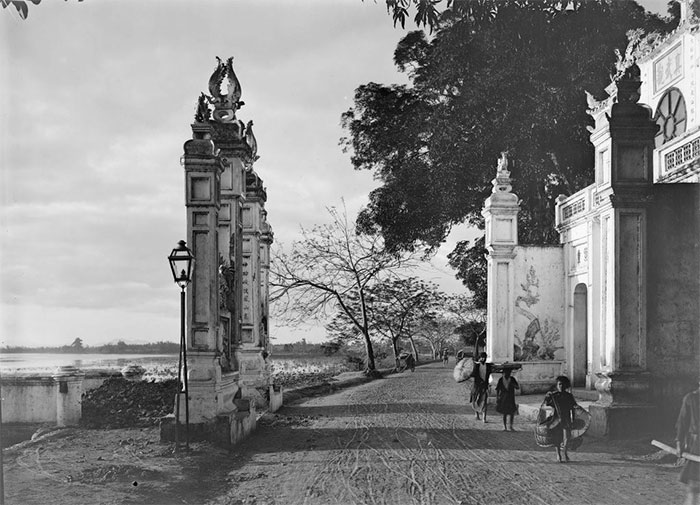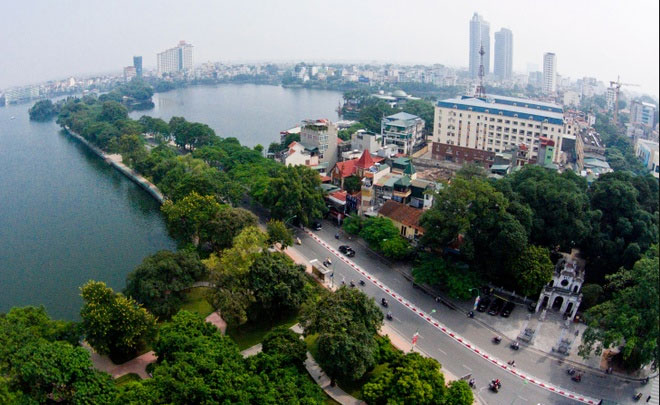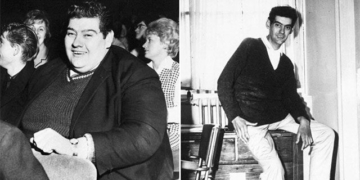Winter in Hanoi is beautiful and romantic. Walking along Thanh Niên Street, looking out over the misty West Lake, one can feel that winter is approaching fast.
On the Co Ngu Dike
Remember the words of mutual affection
Oh girl with the three-tiered hat
Will you come back to Yen Phu on the full moon night?
(Hanoi Folk Poetry)

Co Ngu Street and the ancient gate of Quan Thanh Temple. (Photo: Firmin-André Salles).
Thanh Niên Street, formerly known as Co Ngu Street, is the most romantic street in Hanoi. Some have called it the “love road”, a place that has concealed countless love confessions of the young couples in the capital.
Co Ngu Street evokes memories of ancient Thang Long, reminiscent of the lines “Ancient traces of horse-drawn carriages, the old foundation of castles under the setting sun.” With a history of over 400 years, this road separates West Lake from Truc Bach Lake, resembling the tail of a giant fish (if we imagine West Lake as the body and Truc Bach Lake as the head of the fish).
More than a century ago, Hanoi had many lakes. The lakes were interconnected from West Lake to Ta Vong and Huu Vong Lakes. This is clearly seen in the map of Hanoi drawn by Pham Dinh Bach in 1873.
To the north, the largest is West Lake, followed by Truc Bach Lake, then Co Ngu Lake and Sao Sa Lake. Heading east, there are Huyen Thien Lake, Dong Xuan Lake, Ngu Vong Lake, Thai Cuc Lake, and then Ta Vong and Huu Vong Lakes.
Over time, many lakes were filled in to make way for roads and residential areas. Therefore, Dong Xuan Lake no longer exists, replaced by the Bac Qua market area, and Thai Cuc Lake has left only traces in Cau Go Street, while the Grand Theatre was built on Huu Vong Lake.
In the 17th century, West Lake and Truc Bach Lake were one. Later, locals filled in land and drove bamboo stakes to create a small dike that separated part of West Lake, forming Truc Bach Lake as we know it today.
In the book “Legends and Landmarks of Hanoi” (Cultural Publishing House, 1958), the elder So Bao Doan Kế Thiện cited the book “Long Thành Dật Sử” explaining that this dike was built in 1620 for fishermen to catch shrimp and fish because the upper part of West Lake was quite calm, hence it was called Co Ngu Dike (to hold it securely).
During the Le Dynasty, it was reinforced to become the outer wall of the Thang Long Citadel known as the Northern Defense Dike. During the French colonial period, Co Ngu Dike was named Co Ngu. Some say this name comes from the road resembling the fish’s head, while others claim that the French pronunciation without accents transformed Co Ngu into Co Ngu, which gradually became known as Co Ngu.
In the early 20th century, Co Ngu Dike had not yet taken on the appearance of a street. The road was rough with stones and very narrow, just enough for two handcarts to pass. There were no streetlights, making the area very dark at night. They installed two rows of iron poles along the road, with glass frames on top, containing oil lamps inside.
Each night, someone would bring a ladder to light the lamps from the beginning to the end of the road. According to writer Nguyen Cong Hoan, as late as 1918, these oil lamps were still in use.
In 1931, the City Council renovated Co Ngu Dike by laying stones along both sides to widen it into a road. Co Ngu Dike was no longer winding but took the form of a proper street. The French named this road Lyautey (after a French Marshal). At the end of Co Ngu Street is Tran Vu Temple, one of the four sacred temples of “Thang Long’s Four Guardians.” In the middle of Co Ngu Street lies Truc Bach Pagoda and Cau Nhi Temple.

Thanh Niên Street today. (Photo: Zingnews)
Speaking of Truc Bach Pagoda, it reminds me of a story that still lingers in old newspaper pages. In 1935, a French businessman – the owner of the Métropole Hotel – conspired with the authorities to take part of the pagoda’s land for a refreshment and dance service. This outrageous business “project” was cursed by the people of Hanoi. Even civilized French people could not accept such a profit-driven approach disregarding ethics.
The weekly newspaper L’Eveil économique de L’Indochine (Awakening the Economy of Indochina) bluntly criticized this profit-seeking act as “vulgar,” “uncultured,” and the act of a “thoughtless person.” Thanks to this opposition, the plan was not carried out.
Regrettably, while the civilized French managed to prevent this “vulgar” business from the greedy businessman, there was a time when we fell into the same “thoughtless” business practices. In the 1980s, right next to the serene Truc Bach Pagoda, there was a floating restaurant with flashy colored lights.
Even more heartbreaking is that the Cau Nhi Temple on the island in Truc Bach Lake was completely demolished in the 1980s to build a cooperative production facility, which later turned into “Co Ngu Restaurant.” Fortunately, the Cau Nhi Temple has now been restored to restore the sacredness of this small island. It is a meaningful act by cultured people, even if it is late.
After the capital was liberated, Hanoi entered a new construction phase. On the liberation day of the capital, October 10, 1958, the Hanoi Administrative Committee began the project to widen Co Ngu Road and build Truc Bach Lake Park. This project was entrusted to the youth of the capital to “exclusively” carry out.
Thousands of improved vehicles transported soil and stones from An Duong to reshape the small, rough Co Ngu Road into a spacious and smooth one. The steep Yen Phu slope was lowered to make it easier to traverse.
The area in front of Quan Thanh Temple, where the water from West Lake receded, leaving a muddy puddle, was filled with a lot of earth to create a beautiful flower garden (now Ly Tu Trong Flower Garden).
After countless hours of labor from the youth, the widening of Co Ngu Road was completed. Discussions began on a new name for the road. Most opinions suggested dropping the old name Co Ngu as it was not suitable for the atmosphere of the new capital. It is unclear why they wanted to discard such a beautiful name. A series of new name “nominations” such as Ly Tu Trong Street and Ho Xuan Huong Street were proposed, but no consensus was reached.
The Chairman of the Hanoi Administrative Committee at that time, Dr. Tran Duy Hung, consulted with President Ho Chi Minh and was suggested to name the road Thanh Niên as a tribute to the contributions of the youth of the capital in the road construction.
Thus, Thanh Niên Street has been associated with Hanoi for over half a century and has witnessed countless joys and sorrows of the capital. However, the name Co Ngu has not been forgotten; it lingers in the hearts of those who love Hanoi, gently and romantically echoed in every lyric “The chill of early winter, your scarf fluttering in the cold wind. The milk flowers have fallen, you beside me one afternoon as the classes end. The old Co Ngu Road, we slowly walk back.”


















































